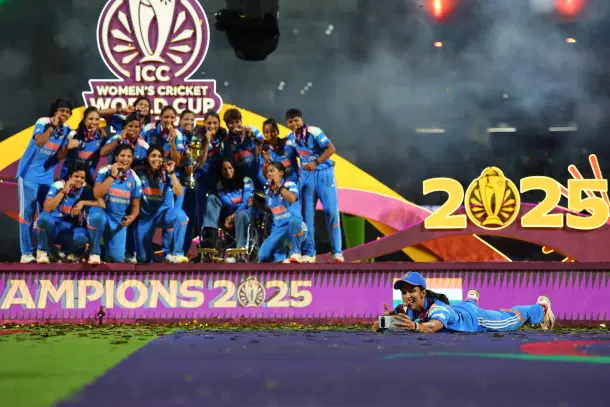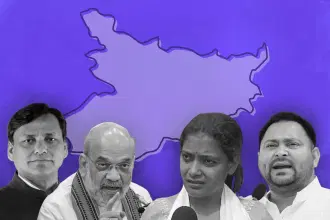Sports
From Borrowed Kits To World Cup, Women's Cricketers Rewrite India's Sporting Destiny
K Balakumar
Nov 03, 2025, 11:45 AM | Updated 11:50 AM IST
Save & read from anywhere!
Bookmark stories for easy access on any device or the Swarajya app.


On a day when India launched its heaviest satellite, GSAT-7R, its women cricketers soared higher with their own GSAT, the Great Sports Achievement & Trophy. The acronym may sound corny or facetious, but there was nothing remotely cheesy or flippant about what Harmanpreet Kaur and her extraordinary band of women achieved at the DY Patil Stadium in Navi Mumbai last night.
In a match that gripped a nation from first ball to last, India defeated a spirited South Africa by 52 runs to lift the Women’s World Cup, its first ever, and perhaps the most transformative moment in Indian sport since Kapil Dev's men rewrote the cricketing script in 1983.
This, however, is not just a win. It can be argued to be an exorcism of a long national neglect.
For decades, women's cricket lived in the margins. Matches played before empty stands, news tucked beneath weather reports, and contracts that could barely pay rent. And yet, from those untelevised, unfunded beginnings, Indian women have willed themselves into a space that once seemed reserved for the men.
This is possibly the first time a women’s game stopped the nation. Hashtags trended on social media platforms, traffic dipped on the streets, and when Harmanpreet took the catch (and even though the time was 12 midnight) living rooms erupted with the same energy that greeted Dhoni's six at Wankhede in 2011.
The night of the new icons
The victory was a team effort carved from nerves, flair, and a never-say-die spirit. Shafali Verma, still just 21, turned the tide early, smashing the new ball with the casual arrogance of youth (87 off 78 balls) and then returning to pick up two crucial wickets in the middle overs.
She showcased a spirit unburdened by past pressures and carried the momentum set by her opening partnership with the ever-consistent Smriti Mandhana, whose elegant contributions throughout the tournament ensured India had a reliable foundation.
Come to think of it, the 21-year-old from Rohtak was rushed into India's squad before the semi-finals after opener Pratika Rawal suffered an injury during their final league-stage match. Also, Shafali had bowled just 14 overs for a single wicket in 30 ODIs so far in her career.
To have her bowl was a gutsy call, or even a cry from the gut that Harmanpreet took. And on the night, it worked magnificently. It took Shefali just two balls to end a threatening 52-run stand between South Africa captain Laura Wolvaardt and Sune Luus. Shefali walked away with the Player of the Match award, but her performance felt larger than a medal. It was, verily, a statement of generational fearlessness.
But the final truly belonged to Deepti Sharma. Hailing from a small town near Agra, Deepti is a true all-rounder, and her remarkable ability with bat and ball was the difference-maker. Her gritty half-century (58 off 58) was followed by a phenomenal five-wicket haul with the ball (5 for 39), earned her the Player of the Series, and perhaps more importantly, reminded the cricketing world that talent comes from unlikely places.
Earlier, Jemimah Rodrigues, effervescent and inventive, had already scripted India's passage to the final with her semi-final heroics against Australia, where her 127 set up the historic win.
Captain 'Harry di', of course, held it all together with strategy and an instinctive understanding of tempo. Her leadership is the invisible glue of this side, allowing younger players like Shree Charani, the 19-year-old spin prodigy from Andhra, and Deepti Ghosh, the wicketkeeper-batter whose nerveless finishing is a talking point, to blossom without fear of failure.
What makes this squad remarkable is its social mosaic. From Haryana's heartland to Mumbai's crowded streets, from Bengal's bylanes to Andhra’s small towns, these women represent the full geography of Indian aspiration. They are, in the truest sense, the face of a new India. All self-made, self-assured, and unwilling to wait for permission to dream.
From shadows to spotlight
It's worth remembering that the women’s cricket World Cup is older than the men's. The first women’s edition was held in 1973, two years before Clive Lloyd lifted the inaugural men's trophy. India itself hosted the women's World Cup as early as 1979, a detail often lost in the mist of male-dominated nostalgia.
But it wasn't until 2005, under the path-breaker Mithali Raj's calm stewardship, that India announced itself to the global stage, reaching its first final. Twelve years later, in 2017, it came within nine runs of glory at Lord's. But, in a sense, those heartbreaks may have seeded belief.
The real inflection point for women's cricket may have arrived when the Women’s Cricket Association of India was brought under the BCCI's umbrella in 2006. Suddenly, the team had access to better infrastructure, coaching, and visibility. It wasn't an overnight revolution, but it gave legitimacy to women's cricket in ways words alone couldn't.
And much recently, Jay Shah's announcement of match-fee parity for men and women in 2022 was more than a policy. Then the arrival of the Women’s Premier League (WPL) changed it all for good. The league didn't just provide financial empowerment. It gave Shafali Verma a fan base, made Smriti a brand, and turned young domestic players into household names.
Interestingly, while male cricketers were barred from foreign leagues, Indian women were encouraged to play in global franchises, (in The Hundred, the WBBL), thereby enriching their game and their global stature.
A nation watches differently now
Perhaps the most telling sign of change is not in last night’s scorecard but in the viewership pattern. The final's peak viewership is said to have shattered all previous records for women's sports in India, rivalling major men’s cricket events.
The final reportedly drew a peak viewership of over 190 million. Digital impressions and stadium attendances set new benchmarks, with DY Patil Stadium packed to the rafters, a far cry from under-attended games as recently as 2013. JioHotstar and TV channels are believed to have seen historical spikes. India vs Pakistan, earlier in the tournament, hit 1.87 billion minutes. Google Trends showed 'Women's Cricket Final' overtaking searches for politics, even outpacing the satellite launch.
Social media was awash with messages from icons like Sachin Tendulkar, Neeraj Chopra, Sundar Pichai, and Satya Nadella. The gist was, 'Barriers Broken. Legends Born'. For a sport that once didn't even have scorecards archived properly, this is a staggering evolution.
And for once, commentary was reverential, not patronising. There were no condescending lines about 'grace under pressure' or 'playing like men.' Instead, the discourse treated them as what they are, elite athletes, uncompromising professionals, and national icons. All through the World Cup, the stadiums boasted equal numbers of men and women, young and old donning blue. And illuminatingly, TV panels debated strategies, not feel-good angles. The memes too mostly were celebratory, not sexist.
A cultural reckoning
As fireworks erupted over Navi Mumbai, the team huddled together, laughing, crying and calling home. Somewhere, Shantha Rangaswamy must have smiled. Diana Edulji and Anjum Chopra would have felt satisfied. Present in the same stadium, Mithali Raj must have felt a quiet completion. And Jhulan Goswami, at hand to embrace the winners, may have experienced generational fulfilment.
This win will doubtless have ripple effects. Expect more girls in gully cricket games. Expect brands to chase women cricketers. Expect WPL broadcast rights to fetch more money. And expect the next generation to grow up with Shafali, Deepti, and Richa as their first cricketing idols.
In a deeper sense, this victory should also redefine 'heroism' in Indian sport. The women's team may have reshaped what national pride looks like, quieter, humbler, but no less fierce. It will also, hopefully, reframe how we consume women's success in general.
Overall, from athletes to entrepreneurs, from scientists to soldiers, Indian women are reclaiming public imagination. Seen in this perspective, last night's victory isn't an isolated sporting miracle. It is a mirror reflecting a society where women are stepping into glory as if to the manner born.
So, in the end, the triumph of Harmanpreet Kaur's team is a testament to the fact that when you give India's daughters an equal platform, equal respect, and equal investment, they will do what they did last night.
Reach for the sky and bring home the stars, that is.





